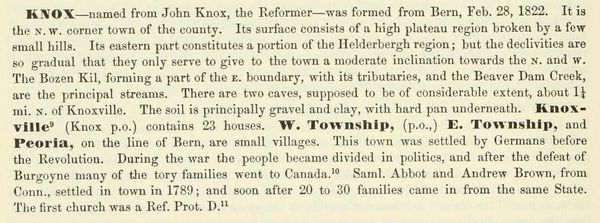Difference between revisions of "1860 French's Gazetteer of the State of New York"
JElberfeld (talk | contribs) m |
JElberfeld (talk | contribs) m |
||
| Line 2: | Line 2: | ||
== Gazetteer of the state of New York: embracing a comprehensive view of the geography, geology, and general history of the state, and a complete history and description of every county, city, town, village and locality with full tables of statistics (1860) == | == Gazetteer of the state of New York: embracing a comprehensive view of the geography, geology, and general history of the state, and a complete history and description of every county, city, town, village and locality with full tables of statistics (1860) == | ||
| − | KNOX named from John Knox, the Reformer was formed from Bern, Feb. 28, 1822. It is the N. W. corner town of the county. Its surface consists of a high plateau region broken by a few small hills. Its eastern part constitutes a portion of the Helderbergh region ; but the declivities are so gradual that they only serve to give to the town a moderate inclination towards the N. and | + | KNOX named from John Knox, the Reformer was formed from Bern, Feb. 28, 1822. It is the N. W. corner town of the county. Its surface consists of a high plateau region broken by a few small hills. Its eastern part constitutes a portion of the Helderbergh region ; but the declivities are so gradual that they only serve to give to the town a moderate inclination towards the N. and W. The Bozen Kil, forming a part of the E. boundary, with its tributaries, and the Beaver Dam Creek, are the principal streams. There are two caves, supposed to be of considerable extent, about 1 1/4 mi. N. of Knoxville. The soil is principally gravel and clay, with hard pan underneath. Knoxville '''(9)''' (Knox p.o.) contains 23 houses. W. Township, (p.o.,) E. Township, and Peoria, on the line of Bern, are small villages. This town was settled by Germans before the Revolution. During the war the people became divided in politics, and after the defeat of Burgoyne many of the tory families went to Canada. '''(10)''' Saml. Abbot and Andrew Brown, from Conn., settled in town in 1789 ; and soon after 20 to 30 families came in from the same State. The first church was a Ref. Prot. D. '''(11)''' |
Latest revision as of 22:14, 13 February 2013
Gazetteer of the state of New York: embracing a comprehensive view of the geography, geology, and general history of the state, and a complete history and description of every county, city, town, village and locality with full tables of statistics (1860)
KNOX named from John Knox, the Reformer was formed from Bern, Feb. 28, 1822. It is the N. W. corner town of the county. Its surface consists of a high plateau region broken by a few small hills. Its eastern part constitutes a portion of the Helderbergh region ; but the declivities are so gradual that they only serve to give to the town a moderate inclination towards the N. and W. The Bozen Kil, forming a part of the E. boundary, with its tributaries, and the Beaver Dam Creek, are the principal streams. There are two caves, supposed to be of considerable extent, about 1 1/4 mi. N. of Knoxville. The soil is principally gravel and clay, with hard pan underneath. Knoxville (9) (Knox p.o.) contains 23 houses. W. Township, (p.o.,) E. Township, and Peoria, on the line of Bern, are small villages. This town was settled by Germans before the Revolution. During the war the people became divided in politics, and after the defeat of Burgoyne many of the tory families went to Canada. (10) Saml. Abbot and Andrew Brown, from Conn., settled in town in 1789 ; and soon after 20 to 30 families came in from the same State. The first church was a Ref. Prot. D. (11)
9 Knoxville was formerly known as "Union Street," and is still
locally called "The Street."
10 Capt. Jacob Van Aernden was an active leader of the whigs of this section during the war.
11 The census reports 6 churches ; 3 M. E., R. P. D., Luth., and Bap.

